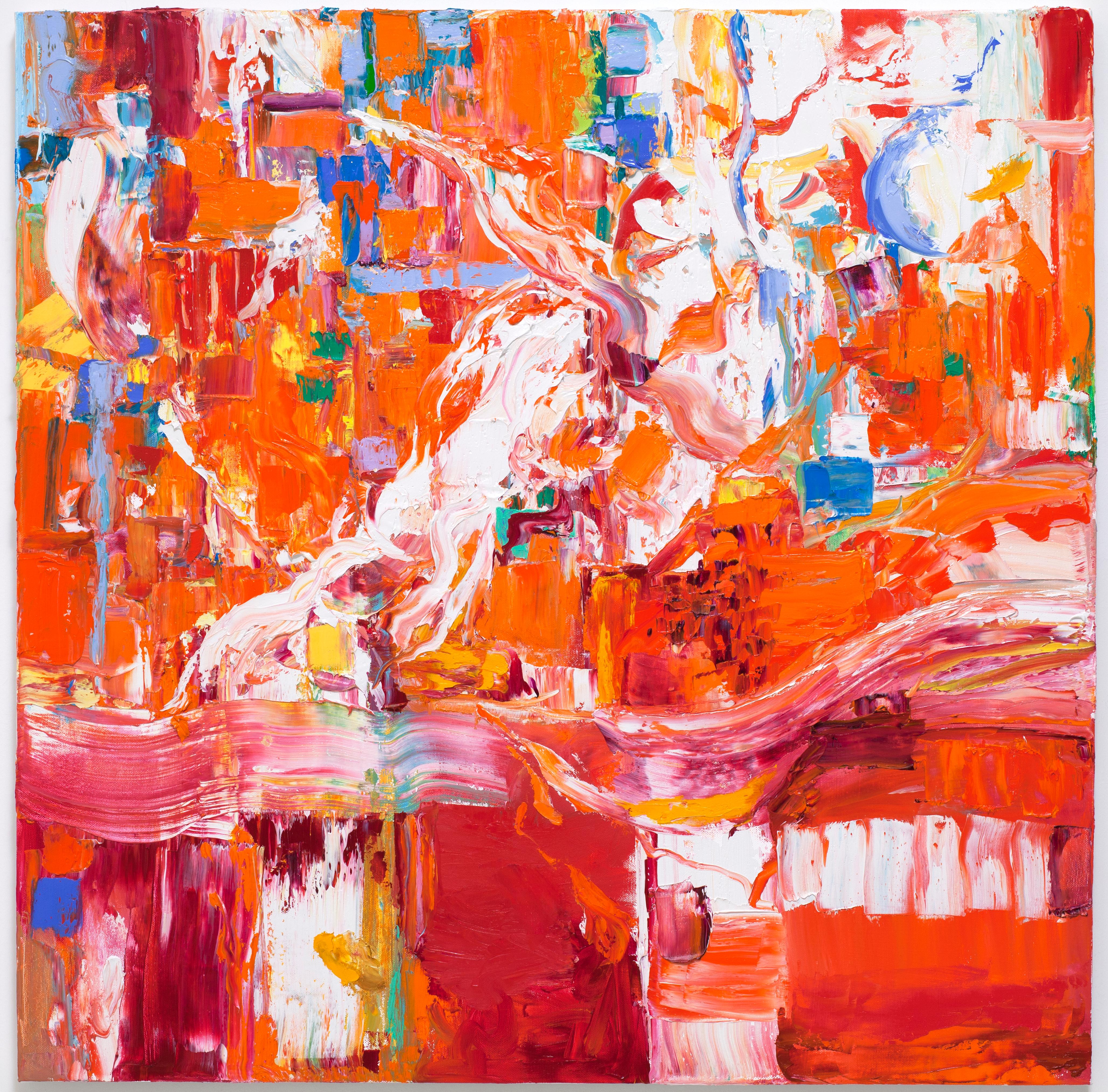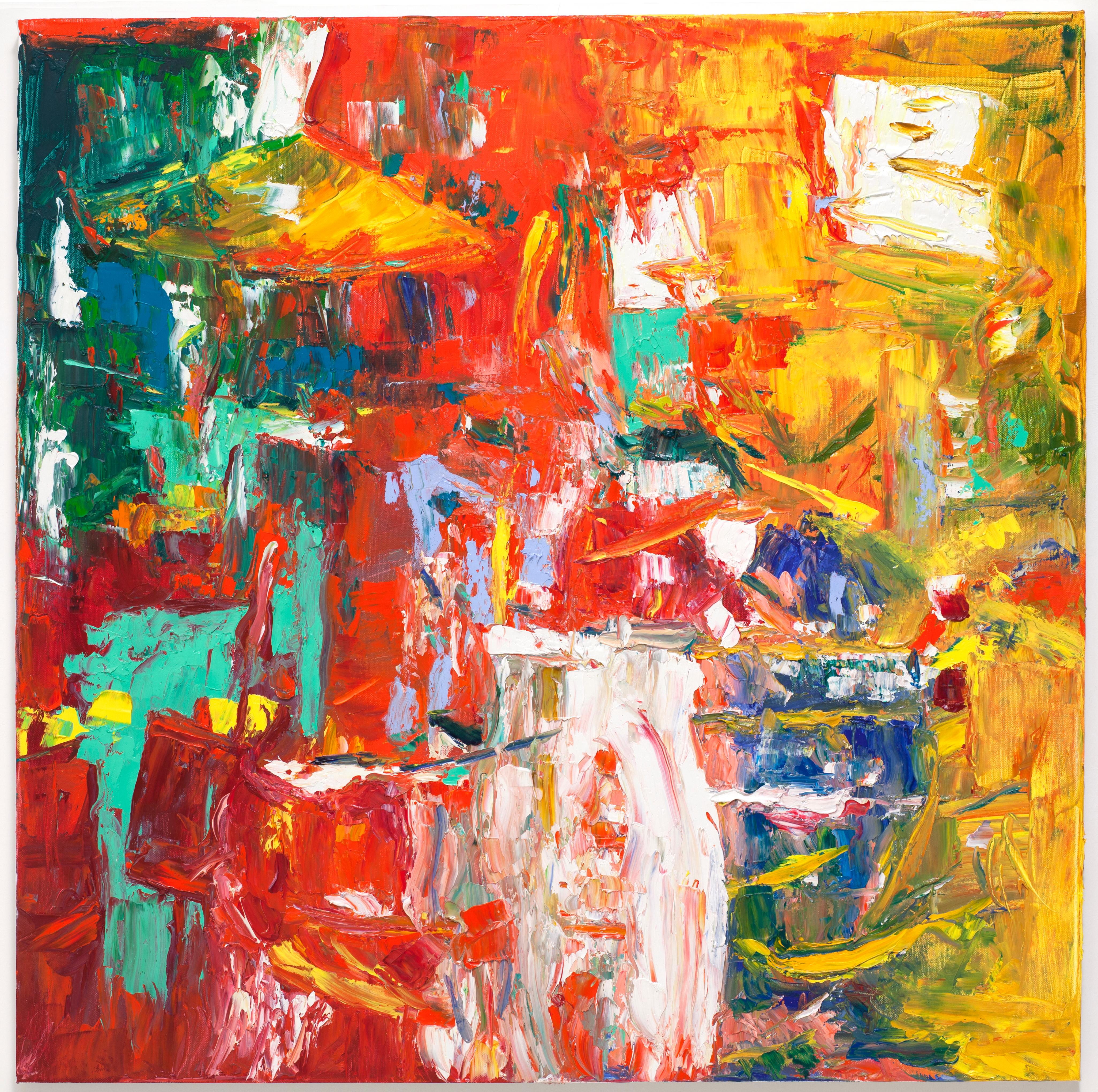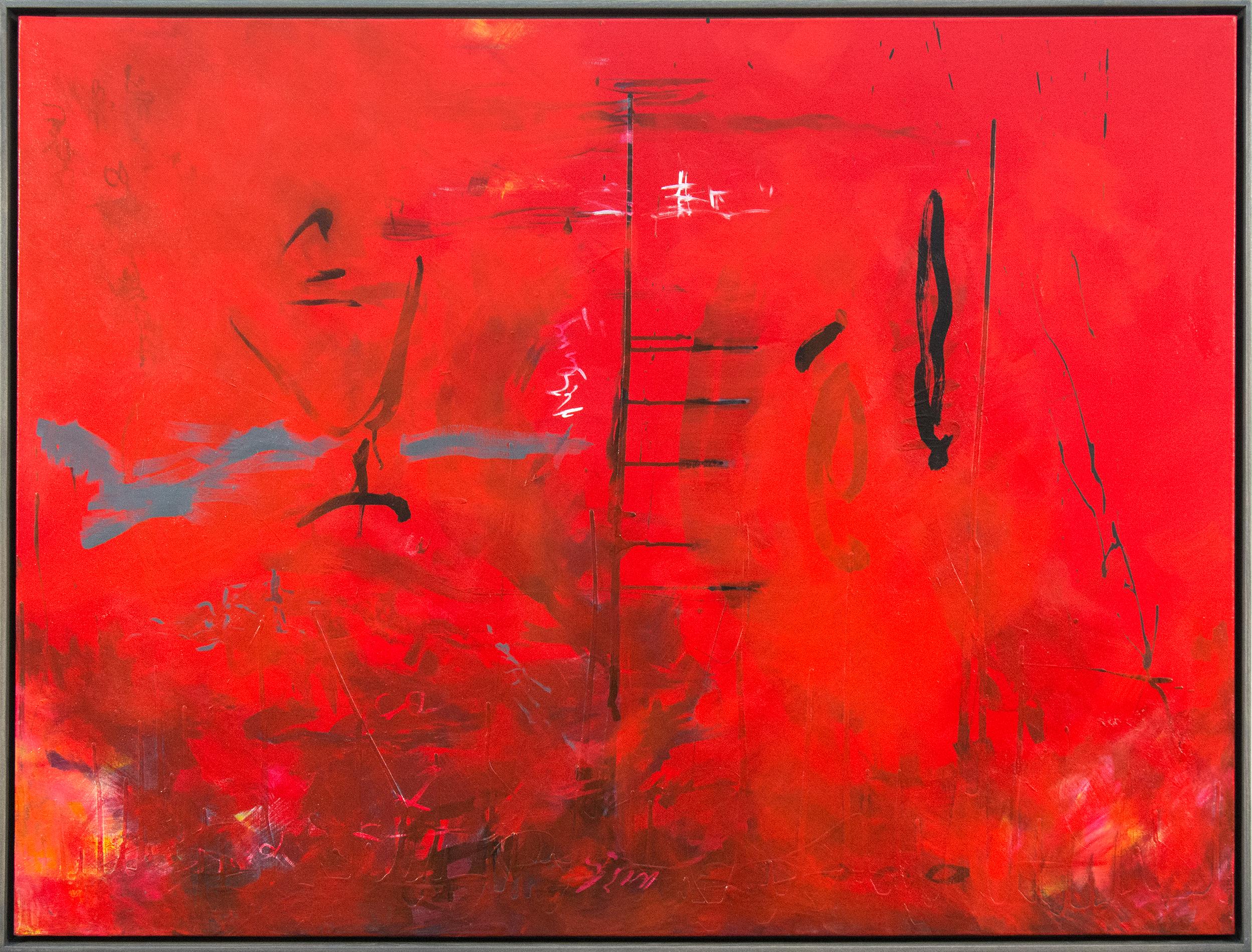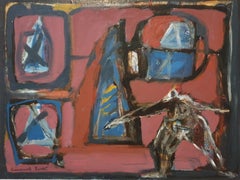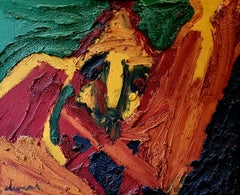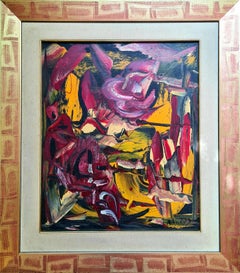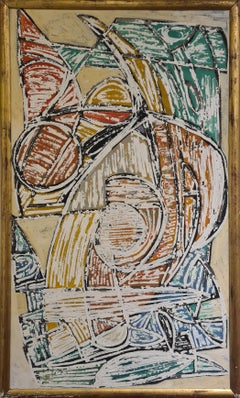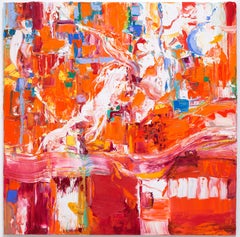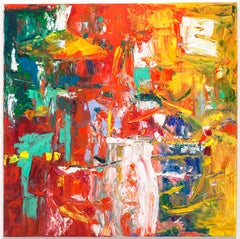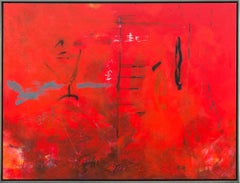Items Similar to Large Abstract Expressionist Oil on Canvas, Convergence Symphony in Red & Orange
Video Loading
Want more images or videos?
Request additional images or videos from the seller
1 of 14
Ernest Engel-PakLarge Abstract Expressionist Oil on Canvas, Convergence Symphony in Red & OrangeAfter 1947
After 1947
$3,863.83
£2,940.45
€3,270
CA$5,408.76
A$5,960.02
CHF 3,091.36
MX$70,886.43
NOK 39,104.87
SEK 36,632.97
DKK 24,910.43
About the Item
A large Mid Century Abstract Expressionist oil on canvas by noted Belgian artist Ernest Engel-Pak. The painting is signed bottom left. Presented in black and silver modern frame.
A powerful explosion of colour and texture, Engel-Pak has used a juxtaposition of colours and forms yet creates out of them a wonderful unified whole. The spirals used throughout the painting are especially intriguing. A truly magnificent painting that would grace any interior or collection.
In his later years Engel-Pak’s Abstract Expressionism evolved to break the confines of his earlier, more contained compositions. His explosive and intense paintings showed total freedom of expression -blurred soft backgrounds contrasted by powerful deep black strokes and pure light. Heavy layers of oil superimposed with more texture and conflicting colour. Dark ink and charcoal worked in impulsive gestures, enabling subconscious discoveries through unbridled exploration. His work was bold, and expressed a new gestural freedom of expression, witnessed in contemporaries like Jackson Pollock and Pierre Soulages. In these years, Engel-Pak exhibited more and featured both solo, and with contemporaries such as Hans Hartung among others. Through a solo show at the Galerie Ravenstein in Brussels, he became recognized as a pioneer of abstract art in the 20th century.
Ernest Engel-Pak was born in 1885 in Spa and around 1900 he started his artistic career by taking drawing classes.
He travelled extensively in Europe and at this time painted under the name of Engel-Rozier.
In 1924, he moved to Paris where he exhibited for the first time in 1926 at the Galerie Vignol, portraits, views of Corsica and popular scenes, including the paintings: The Phenomenon, The Men in the Café, The Newsagent, In the Metro and The Lost. He was in contact with Torres-Garcia, whom he met in 1928 and who was also a friend of Jean Hélion and Marcel Duchamp. In 1934, he moved to Provence. After the war, his work was the subject of group exhibitions by abstract artists, notably at the Salon des Réalités Nouvelles between 1947 and 1956. He had a number of solo exhibitions in Spain, France, Holland and Belgium and a retrospective exhibition of his work was held in Aix-en-Provence in 1966.
Influenced by the cubism of Torres-Garcia, from 1926 onwards his paintings became more monumental and more structured. Following his discovery of Surrealism in 1929, he turned to lyrical and abstract art. He exhibited with the Surindépendants in Paris. In 1931 in Brussels, he was one of the founders of the Journal des poètes. Settled in Sanary in 1934, for ten years he led a retired life as a painter and farmer. From 1943, he signed Engel-Pak. In 1946, he joined the group of New Realities and illustrated Paul Eluard's text Objects of Words and Images.
Abstract Expressionism, also known as Action Painting or Colour Field Painting, exploded onto the art scene after World War II with its characteristic messiness and extremely energetic applications of paint.
Abstract Expressionism is also referred to as gestural abstraction because its brush strokes revealed the artist's process. This process is the subject of the art itself. As Harold Rosenberg explained: the work of art becomes an "event." For this reason, he referred to this movement as Action Painting.
Many modern-day art historians believe that his emphasis on action leaves out another side of Abstract Expressionism: control vs. chance. Historians posit that Abstract Expressionism comes from three major sources: Kandinsky's abstraction, the Dadaist's reliance on chance, and the Surrealist's endorsement of Freudian theory that embraces the relevance of dreams, sexual drives ( libido) and the authenticity of ego (unfiltered self-centeredness, known as narcissism), which this art expresses through "action."
Despite the paintings' apparent lack of cohesion to the uneducated eye, these artists cultivated the interplay of skill and unplanned occurrences to determine the painting's final outcome.
( Thanks to Beth Gersh-Nesic )
- Creator:Ernest Engel-Pak (1885 - 1965, Belgian)
- Creation Year:After 1947
- Dimensions:Height: 19.3 in (49 cm)Width: 34.45 in (87.5 cm)Depth: 0.79 in (2 cm)
- Medium:
- Movement & Style:
- Period:
- Condition:Some wear and chips to the frame, small areas of paint loss due to thick medium.
- Gallery Location:Cotignac, FR
- Reference Number:Seller: LG/EngelPak1stDibs: LU1430215137582
About the Seller
5.0
Platinum Seller
Premium sellers with a 4.7+ rating and 24-hour response times
Established in 2000
1stDibs seller since 2020
281 sales on 1stDibs
Typical response time: 1 hour
- ShippingRetrieving quote...Shipping from: Cotignac, France
- Return Policy
More From This Seller
View All"Redoutable" (Formidable) Colourful French Abstract Expressionist Oil on Board.
Located in Cotignac, FR
Late 20th century abstract Expressionist oil on board by French artist Emmanuelle Bardet. Signed bottom left and dated 1995 and titled "Redoutable" (Formidable) to the reverse. The a...
Category
Late 20th Century Abstract Expressionist Abstract Paintings
Materials
Oil, Board
Abstract Expressionist Abstract Large Oil on Canvas, Le Pèlerin.
Located in Cotignac, FR
Expressionist abstract oil on canvas by French artist Bernard Duvert. The painting is signed bottom left, dated and titled to the rear stretchers and with exhibition numbers.
A magn...
Category
Late 20th Century Neo-Expressionist Abstract Paintings
Materials
Canvas, Oil
$4,537 Sale Price
20% Off
French Abstract Expressionist Oil on Canvas, Les Alliance au Crepuscule
Located in Cotignac, FR
French late 20th Century Abstract Expressionist oil on canvas by Abstrus. The painting is signed bottom right and signed titled and dated to the rear stretcher. Presented in a fine b...
Category
Late 20th Century Abstract Expressionist Abstract Paintings
Materials
Canvas, Oil
Large Aboriginal-Inspired Abstract Oil on Board.
Located in Cotignac, FR
Large Aboriginal-inspired abstract oil on board. We have shown the painting hanging in 'portrait' form but it could also be hung 'landscape'.
This painting shares some of the qualit...
Category
Mid-20th Century Neo-Expressionist Abstract Paintings
Materials
Oil, Board
'Monogrammes'. French Mid-Century Abstract Expressionist. Oil on Canvas.
Located in Cotignac, FR
A mid-century abstract expressionist oil on canvas presented in a plain wooden frame. The work is titled and there are initials 'G.O.' (artist?) on a label to the rear stretcher as w...
Category
Mid-20th Century Contemporary Abstract Paintings
Materials
Canvas, Oil
French Mixed Media Abstract Expressionist, Symphony in Blue and Red
Located in Cotignac, FR
French mixed media abstract expressionist painting by Danièle Jaquillard. The painting is signed and dated bottom right. Presented in a custom, painted tray frame.
A strong and impa...
Category
Late 20th Century Abstract Expressionist Abstract Paintings
Materials
Oil, Watercolor, Gouache, Tissue Paper
You May Also Like
"Large Abstraction" Orange Red Expressionist Bold Colorful Oil Paint
By Linda Holt
Located in Wellesley, MA
"Orange Red," Oil on Canvas, 30 x 30 Inches, is a brilliantly colored, gorgeous and lush abstraction, very expressionist and fluid in style in shades of orange, yellow, red, white, ...
Category
2010s Abstract Expressionist Abstract Paintings
Materials
Oil
"Untitled" Large Abstract Expressionist Red Orange Yellow Bold Colorful
By Linda Holt
Located in Wellesley, MA
"Larger Abstraction (Untitled)," Oil on Canvas, 30 x 30 Inches, is a brilliantly colored, gorgeous and lush abstraction, very expressionist and fluid in style in red, orange, yellow...
Category
2010s Abstract Expressionist Abstract Paintings
Materials
Oil
Red II, Abstract Oil Painting on Canvas by Gustavo Schmidt
By Gustavo Schmidt
Located in Long Island City, NY
Artist: Gustavo Schmidt
Title: Red II
Year: 2016
Medium: Oil on Canvas, signed and titled verso
Size: 54 x 44 inches
Category
2010s Abstract Expressionist Abstract Paintings
Materials
Canvas, Oil
Seeing Through Red - bold, vibrant, gestural abstraction, acrylic on canvas
By Lynne Fernie
Located in Bloomfield, ON
Dashes of charcoal and black dance on a fiery red ground in this emotive acrylic painting by Lynne Fernie.
Lynne Fernie is a Toronto-based artist, OCAD University honors graduate an...
Category
2010s Contemporary Abstract Paintings
Materials
Canvas, Acrylic
Mid-Century Modern Extra-Large Red Abstract Oil Painting By Kai Lindemann
Located in Frederiksberg C, DK
An extra-large red abstract composition that invigorates the bystander with its powerful red and black color play. This oil painting is an exquisite example of a mid-century modern a...
Category
1960s Post-War Abstract Paintings
Materials
Canvas, Oil
Orange Abstract - Italian/South African sixties abstract art oil painting
By Armando Baldinelli
Located in Hagley, England
This vibrant abstract oil painting is by Italian born but South African based artist Armando Baldinelli. It was painted circa 1960 after Baldinelli left Italy for South Africa and wa...
Category
1960s Abstract Abstract Paintings
Materials
Oil
